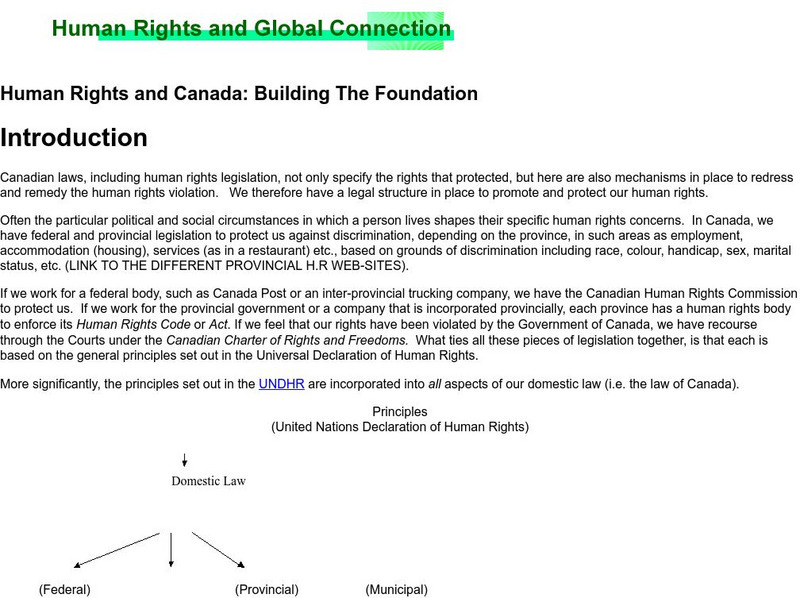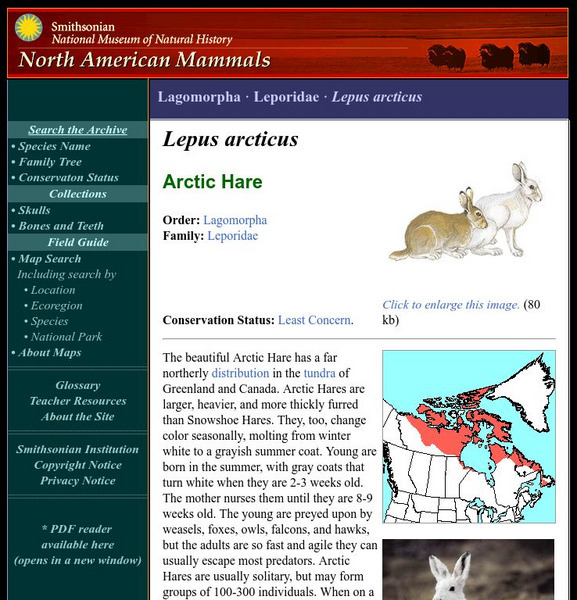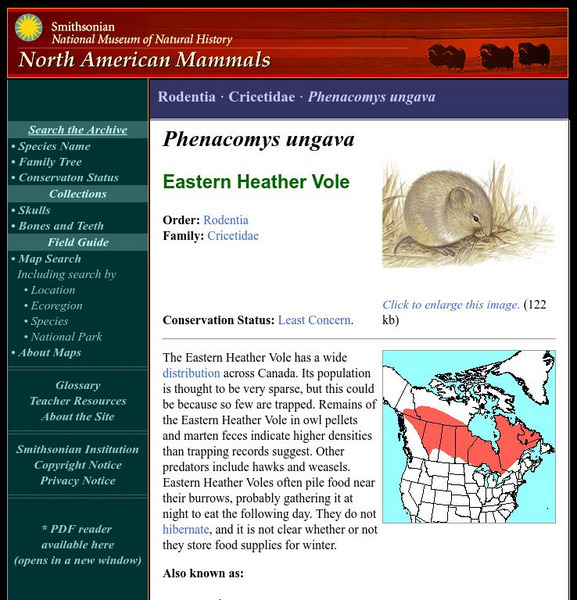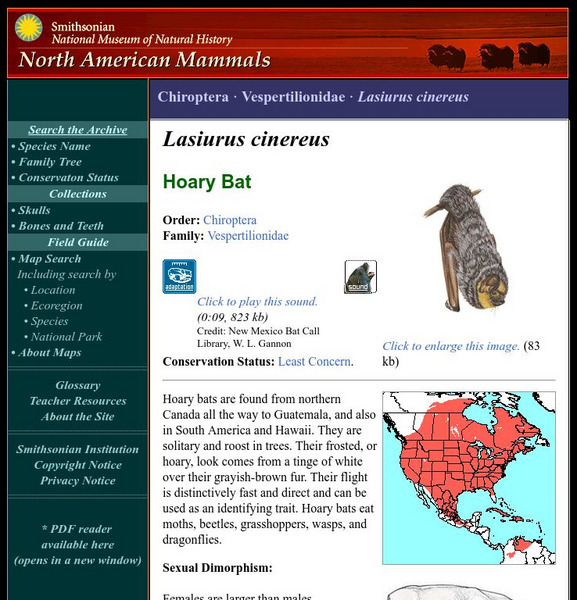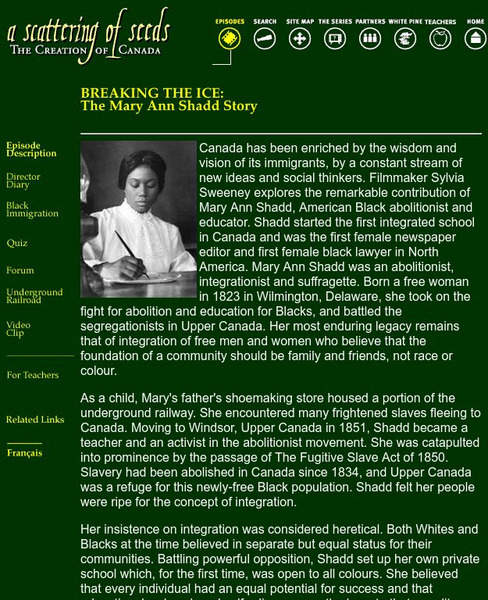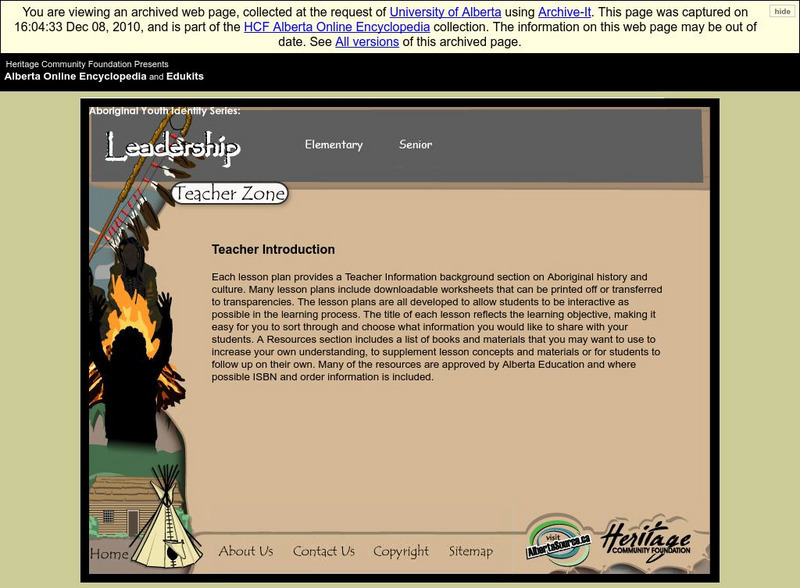Other
Human Rights and Canada: Building the Foundation
This site provides background on the history of human rights in Canada and events that influenced their evolution. It explains how the principles of the United Nations Declaration of Human Rights is embedded in Canadian laws that protect...
Smithsonian Institution
National Museum of Natural History: American Mammals: American Marten
American Martens are widely distributed in northern forests across Canada and into Alaska. Only 200 years ago, they were also abundant in the southeastern United States. Learn more about the Martes americana, more commonly known as an...
Smithsonian Institution
National Museum of Natural History: American Mammals: Barren Ground Shrew
An inhabitant of the far north, the Barren Ground Shrew lives on the tundra from Point Barrow, Alaska, to the western shore of Hudson Bay, Canada. The fur on its back forms a well-defined brown stripe, and its sides and undersides are...
Smithsonian Institution
National Museum of Natural History: American Mammals: Arctic Hare
The beautiful Arctic Hare has a far northerly distribution in the tundra of Greenland and Canada. Arctic Hares are larger, heavier, and more thickly furred than Snowshoe Hares. Learn more about the Lepus arcticus, more commonly known as...
Smithsonian Institution
National Museum of Natural History: American Mammals: Western Small Footed Myotis
The western small-footed myotis occurs in limited areas of southwestern Canada, throughout much of the western United States, and into Mexico. It is better adapted to moist areas than to dry ones. Learn more about the Myotis ciliolabrum,...
Smithsonian Institution
National Museum of Natural History: American Mammals: Eastern Red Bat
Common and widespread from far southern Canada throughout most of the United States and Mexico, and farther south through Central America and into South America, the Eastern Red Bat requires trees and shrubs for roosting. It is...
Smithsonian Institution
National Museum of Natural History: American Mammals: Vancouver Marmot
Vancouver Marmots live only on Vancouver Island, British Columbia. They are the only endangered mammal in Canada, with a population estimated at only 100-200 individuals. Learn more about the Marmota vancouverensis, more commonly known...
Smithsonian Institution
National Museum of Natural History: American Mammals: Olive Backed Pocket Mouse
The striking olive dorsum of the Olive-backed Pocket Mouse is set off by a yellowish stripe on the side and a white underside. This is the only species of pocket mouse east of the Rocky Mountains whose range extends well into Canada....
Smithsonian Institution
National Museum of Natural History: American Mammals: Prairie Shrew
The Prairie Shrew is small, weighing only 2-5 g, brown, and relatively short-tailed. This species inhabits the northern Great Plains in Canada and the United States. Learn more about the Sorex haydeni, more commonly known as a Prairie...
Smithsonian Institution
National Museum of Natural History: American Mammals: Marsh Shrew
Large for a shrew and with velvety dark fur, the Marsh Shrew can be found in marsh, stream, and beach habitats of the coastal rain forest in extreme southwestern Canada and the Pacific Northwest of the United States. This shrew is...
Smithsonian Institution
National Museum of Natural History: American Mammals: Eastern Heather Vole
The Eastern Heather Vole has a wide distribution across Canada. Its population is thought to be very sparse, but this could be because so few are trapped. Learn more about the Phenacomys ungava, more commonly known as an Eastern Heather...
Smithsonian Institution
National Museum of Natural History: American Mammals: Hoary Bat
Hoary bats are found from northern Canada all the way to Guatemala, and also in South America and Hawaii. They are solitary and roost in trees. Learn more about the Lasiurus cinereus, more commonly known as a Hoary Bat, in this...
Smithsonian Institution
National Museum of Natural History: American Mammals: Northern Pocket Gopher
Of all North American pocket gophers, the Northern Pocket Gopher has the widest distribution, across most of the western United States and south-central Canada, and it occurs in the greatest variety of habitats. Only habitats with a...
Other
Penguin Group Canada: Our Canadian Girl Author Julie Lawson
Julie Lawson is interviewed here about her book 'Emily: Across The James Bay Bridge', which is part of the Our Canadian Girl series. She discusses her interest in Victoria, B.C.'s history.
Library of Congress
Loc: Legacy of French Canadian Immigrants in New England
Designed by American Memory Fellows Linda Hamel and Linda Hedrirck, this site explores the settlements of French Canadians in New England in the late 19th and early 20th centuries. It provides teachers complete lesson plans for 8...
Other
The Royal Tyrrell Muesum
This site includes exhibits of the museum, school programs, public programs, research and resources, etc.
University of Toronto (Canada)
Canadian Painters as Art Educators 1920 1950
Interesting general discussion of Canadian art and artists between 1920-1950 that was a new generation of painters than before the First World War. Gives biographical information on a variety of different painters with examples of their...
Curated OER
Association of Religion Data Archives: National Profiles: Canada
Learn about religion in Canada, in this Association of Religion Data Archives country profile, which includes general facts, history, and religious data.
Alberta Online Encyclopedia
Alberta Online Encyclopedia: Alberta Heritage: How the West Was Young
A look inside the history of the province of Alberta. The resource delves into the following topics: Alberta's pre-contact history, its native origins, its political history, and contemporary issues, such as Alberta's vast resources in oil.
White Pine Pictures
White Pine Pictures: Breaking the Ice: The Mary Ann Shadd Story
Mary Ann Shadd was born in Wilmington, Delaware in 1823. She emigrated to Windsor, Upper Canada and was a leader in advocating for integrated schools at a time when most Canadians believed segregated schools should predominate. This web...
Countries and Their Cultures
Countries and Their Cultures: Multicultural America: Canadian Americans
Provides an overview of the history, culture, and lifestyle of Canadian Americans. (Note: Content is not the most current.)
Wikimedia
Wikipedia: Intercolonial Railway
A comprehensive site that examines the building of the railway from the east coast to the west coast of Canada. The section under History describes Canada's desire to have an intercontinental railway to secure Canada's future during the...
White Pine Pictures
White Pine Pictures: Watari Dori: A Bird of Passage
This is a good way to educate students about Japanese internment camps. This follows the story of one woman and her triumphant return to Canada. Includes a quiz and lesson plans.
Alberta Online Encyclopedia
Alberta Online Encyclopedia: Aboriginal Youth Identity Series: Teacher Zone
This website provides educators with an opportunity to learn and teach about Aboriginal Leadership in Canada. The elementary section focuses on identifying Aboriginal role models and heroes such as Bill Reid, Buffy Sainte-Marie, or...
Other popular searches
- Canada History 1920's
- Caribbean History in Canada
- Canada History Louis Riel
- Family Canada History
- Canada History Technology
- Canada History 1920 1929
- Canada History First Nations
- Canada History Major Events
- Canada History Grade Five
- Canada History Wwi
- History of Canada
- Canada History Timeline


